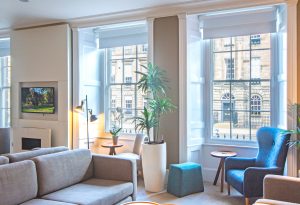Collaboration at early stage design for secondary glazing specification in all types of commercial and residential projects delivers positive benefits all round, explains Mike Latham from commercial sales at Granada Secondary Glazing
Secondary glazing is the proven cost-effective, efficient and discreet solution to cure issues with external noise, thermal efficiency and enhance security in buildings of all ages. When correctly installed, secondary glazing can make buildings 80% quieter by reducing noise levels up to 54dB.
Secondary glazing addresses noise, thermal and security issues
 Extra insulation provided by secondary glazing can eliminate draughts and heat loss by up to 65%, while the robust aluminium frames securely fixed internally enhance security by deterring unwanted intrusion.
Extra insulation provided by secondary glazing can eliminate draughts and heat loss by up to 65%, while the robust aluminium frames securely fixed internally enhance security by deterring unwanted intrusion.
For heritage and listed buildings with single glazed primary windows, installing secondary glazing is often the preferred option for creating a warmer, quieter and more secure environment with the original windows intact. Slimline aluminium frames are virtually invisible, maintaining a building’s charm and character while bringing the glazing system firmly into the 21st century.
At Granada Glazing, we place great emphasis on early stage design, where taking a collaborative approach with architects and clients allows us to thoroughly explore and identify specific issues – be they acoustic, thermal or security – before recommending the best secondary glazing solutions. In our experience, this approach contributes greatly to successful project outcomes.
Key questions at the early design stage
A key question will be who is using the building once it is completed? What access is required to the window for cleaning, maintenance and natural ventilation? Are there soft furnishings, curtains or blinds that could impact on how the secondary frames operate?
Answering these fundamental questions at the outset determines the specification of the secondary glazing system to suit the requirements of those living with the windows, be they paying guests, office workers or homeowners.
 In hotels, for example, cleaning staff will open the windows to ventilate rooms during the cleaning process. So it is important that soft furnishings do not obstruct or affect the opening of secondary glazing frames on a daily basis.
In hotels, for example, cleaning staff will open the windows to ventilate rooms during the cleaning process. So it is important that soft furnishings do not obstruct or affect the opening of secondary glazing frames on a daily basis.
It is incumbent upon us as a glazing contractor and manufacturer to work with architects and specifiers to optimise the early stage design process, thereby ironing out any issues promptly and ensuring that there are no surprises further down the track.
As a collaborative partner, the Granada Glazing technical team examines the main issues that secondary glazing can cure and then advise on what is required. For example, what cavity width is required between the primary and secondary glazing to achieve the optimum result? Or would a different Low-E glass or coatings work better?
All these questions around the performance criteria can be discussed and answers given at the early stage design process. Once these answers are agreed in principle, we can move forward with a ‘design intent’. From there, the architect can draw up the secondary glazing specification to form part of the tender for the main contractor and all interested parties to work on.
Early stage design plays a crucial role in ensuring any potential pitfalls and issues have been addressed and resolved in reaching the ideal secondary glazing solution.
Granada Glazing partners with architects and specifiers on the design, manufacture and supply of high quality commercial secondary glazing for all sectors and building types across the UK.
Tel: +44 (0) 1909 499 899
Please note: this is a commercial profile.














